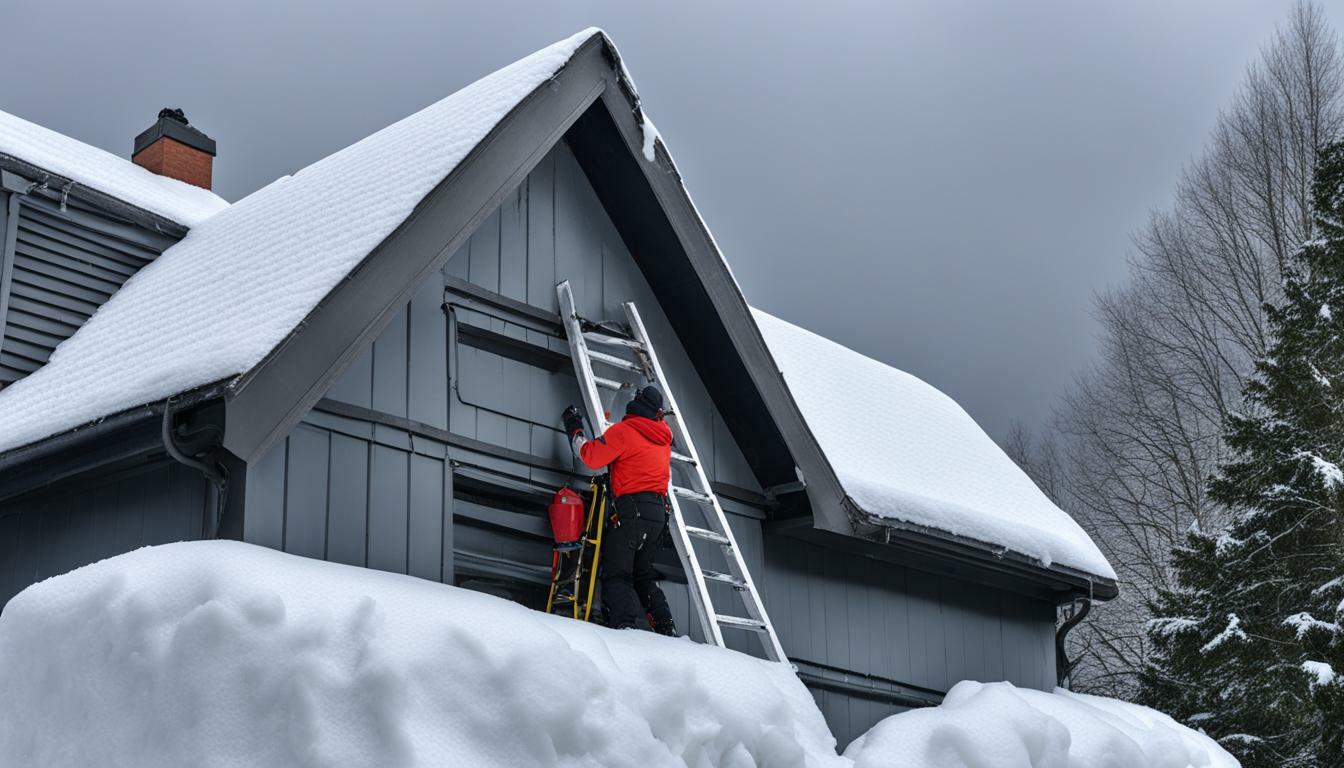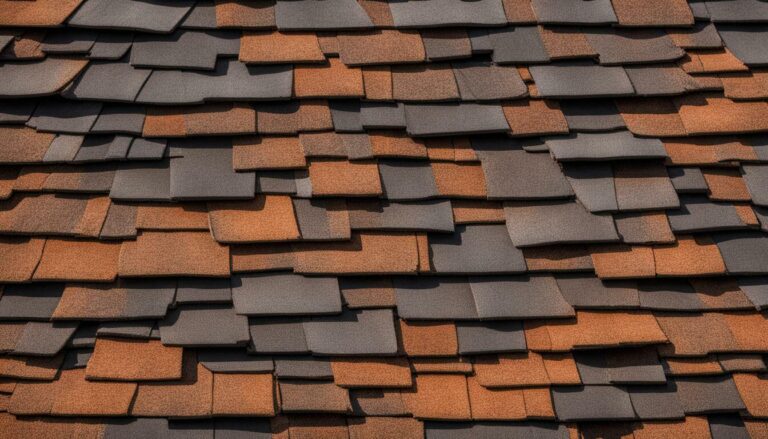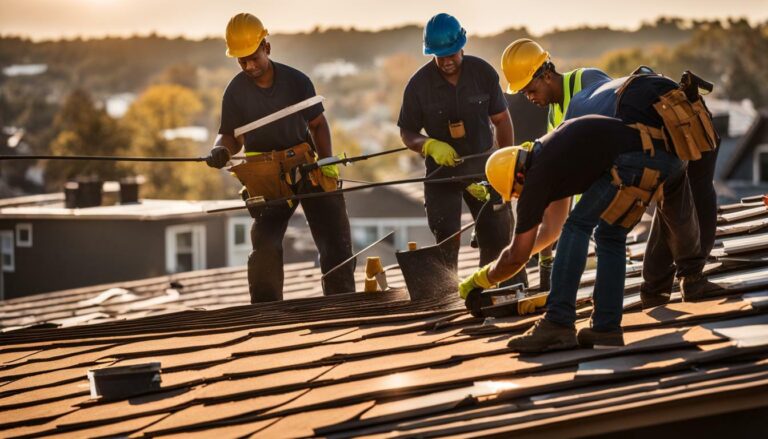Essential Guide to Winterizing Your Roof – Secure Your Home
Winterizing your roof is crucial in ensuring the safety and security of your home during the cold winter months. As the temperature drops and harsh weather conditions set in, taking steps to prepare your roof for winter is essential to prevent potential damage and costly repairs.
Before winter arrives, it is important to thoroughly inspect your roof for any damages. Look for missing or cracked shingles, as well as any signs of wear and tear that may make your roof vulnerable to leaks and structural issues. Addressing these problems early on will help protect your home throughout the winter season.
Key Takeaways:
- Inspect your roof for damages before winter
- Replace missing or cracked shingles
- Trim tree limbs close to your house to prevent damage during storms
- Clean gutters and drain pipes to avoid water damage
- Ensure proper insulation and ventilation in your attic
By taking the necessary steps to winterize your roof, you can enjoy several benefits. Not only can it save you money on heating costs by improving insulation, but it also protects your home from water damage that can result from leaks and ice dams. Additionally, winterizing your roof helps to extend its lifespan and ensures a safer environment for you and your loved ones.
Don’t overlook the importance of getting a professional roof inspection. A trained eye can identify weak points and potential problems that may go unnoticed to the untrained eye. Investing in a professional inspection can help you address any issues before they escalate and lead to more significant damage.
It is also crucial to have a plan for snow removal. Heavy snow buildup can put excessive weight on your roof and cause structural damage if not properly addressed. Take proactive measures to remove snow from your roof to prevent costly repairs and potential collapses.
Key Takeaways:
- Get a professional roof inspection to identify potential issues
- Have a plan for snow removal to prevent damage
- Winterizing your roof improves insulation and extends its lifespan
- Protect your home from water damage caused by leaks and ice dams
- Ensure a safer environment for you and your loved ones
In conclusion, winterizing your roof is a crucial step in protecting your home during the cold winter months. By inspecting your roof, repairing any damages, trimming tree limbs, cleaning gutters, insulating your attic, and having a plan for snow removal, you can safeguard your home from potential winter-related issues. Don’t underestimate the importance of taking proactive measures to ensure the longevity and safety of your roof.
Why Winterizing Your Roof is Important
Winter weather can wreak havoc on your roof, causing leaks, structural damage, and costly repairs if not properly prepared and winterized. Protecting your roof in winter is essential to ensure the safety and durability of your home. By taking the necessary steps to winterize your roof, you can prevent potential damage and save yourself from expensive repairs.
Preparing Your Roof for Winter
Before winter arrives, it is important to inspect your roof for any existing damages. Look for missing or cracked shingles, signs of water damage, or any other issues that need immediate attention. Replace or repair any damaged shingles to strengthen your roof’s integrity.
Additionally, trimming tree limbs close to your house is crucial in preventing them from falling on your roof during winter storms. The weight of snow and ice can cause weak tree limbs to snap and damage your roof, so it is important to keep them well-trimmed and away from your home.
Cleaning your gutters and drain pipes is another essential step in winter roof preparation. Clogged gutters can lead to water backup, which can then freeze and create ice dams on your roof. Regular cleaning ensures proper water flow and helps prevent water damage.
Insulation and Professional Inspection
Proper insulation and ventilation in your attic play a vital role in protecting your roof during winter. Insufficient insulation can cause heat to escape, leading to ice dams and water damage on your roof. Ensure that your attic is properly insulated and ventilated to prevent freezing and expanding of water beneath the shingles.
Getting a professional roof inspection before winter is highly recommended. A trained professional can identify weak points in your roof, potential problems, and provide necessary repairs or maintenance. This proactive approach can save you from costly repairs down the line.

Winterizing your roof offers numerous benefits. By protecting your roof in winter, you can save on heating costs as proper insulation keeps your home warm and energy-efficient. Additionally, a well-prepared roof prevents water damage, which can lead to mold growth and structural issues.
Proper winter roof preparation also improves insulation, keeping your home comfortable and reducing energy consumption. By winterizing your roof, you are investing in the long-term durability and safety of your home.
| Winter Roof Checklist: |
|---|
| Inspect your roof for damages and replace any missing or cracked shingles. |
| Trim tree limbs close to your house to prevent them from falling during winter storms. |
| Clean gutters and drain pipes to avoid water backup. |
| Ensure proper insulation and ventilation in your attic to prevent ice dams. |
| Get a professional roof inspection to identify weak points and potential problems. |
| Create a snow removal plan to prevent heavy snow buildup on your roof. |
In conclusion, winterizing your roof is a crucial step in protecting your home during the cold weather. By taking the necessary precautions and following the winter roof checklist, you can ensure the longevity and safety of your roof, saving yourself from costly repairs and potential damage.
Inspecting Your Roof for Damages
Before winter sets in, it’s essential to conduct a thorough inspection of your roof to identify any damages that need to be addressed. The harsh cold weather can exacerbate existing issues, leading to costly repairs down the line. Here are some winter roof tips to help you effectively inspect your roof:
- Check for missing or cracked shingles: Start by visually inspecting your roof for any missing or damaged shingles. Replace them promptly to prevent water leakage and further damage.
- Examine the flashing: Pay close attention to the flashing around chimneys, vents, and skylights. Inspect for any signs of wear or damage, such as cracks or rust. Damaged flashing can allow water to seep in, leading to leaks.
- Look for signs of water damage: Inspect the interior of your home for any water stains or discoloration on the ceilings or walls. These can indicate roof leaks and should be addressed immediately.
- Inspect the attic: Enter your attic and check for any signs of moisture, such as damp insulation or water stains. Proper attic insulation and ventilation are crucial in preventing ice dams and reducing the risk of water damage.
Remember, safety should always be a priority when inspecting your roof. If you’re uncomfortable or unsure about climbing onto your roof, it’s best to hire a professional roofer who can perform a comprehensive inspection and address any issues they find.
Winter Roof Tips: The Importance of Regular Inspections
Regular roof inspections are a crucial part of winter roof maintenance. By identifying and addressing potential issues early on, you can prevent extensive damage and costly repairs. Neglecting regular inspections can lead to leaks, structural damage, and compromised insulation, which can significantly impact your home’s energy efficiency during the colder months.
| Benefits of Regular Inspections: | Steps to Take: |
|---|---|
| Early detection of roof damage | 1. Conduct inspections at least twice a year – in fall and spring |
| Prevention of water leaks and moisture buildup | 2. Use a sturdy ladder and appropriate safety equipment |
| Identification of potential hazards, such as loose shingles or deteriorating flashing | 3. Thoroughly examine the roof surface, flashing, and gutters |
| Prolonged lifespan of your roof | 4. Address any issues promptly or hire a professional roofer |
By following these winter roof tips and conducting regular inspections, you can ensure that your roof remains in optimal condition throughout the cold season, providing you with peace of mind and protecting your home from potential damage.
Repairing or Replacing Damaged Shingles
Damaged or missing shingles can compromise the integrity of your roof, especially during winter when it faces harsh weather conditions. It is crucial to inspect your roof thoroughly and address any issues before the cold weather sets in. By repairing or replacing damaged shingles, you can ensure that your roof remains sturdy and protected throughout the winter.
Start by conducting a visual inspection of your roof, looking for any signs of damage such as cracks, curling, or missing shingles. Pay close attention to areas where shingles meet, as these are prone to leaks and water damage. Use caution when walking on your roof and wear appropriate safety gear to prevent accidents.
If you notice any damaged or missing shingles, it is best to replace them promptly. This will help preserve the overall integrity of your roof and prevent further damage from occurring. When replacing shingles, ensure that you use matching materials and follow proper installation techniques. If you are unsure of how to do this, it is advisable to seek professional help to ensure the job is done correctly.
Remember, winter weather can be harsh on your roof, so it is essential to address any shingle issues before the season arrives. By taking the time to repair or replace damaged shingles, you can protect your home from potential leaks, water damage, and expensive repairs. Don’t neglect this important step in winterizing your roof!
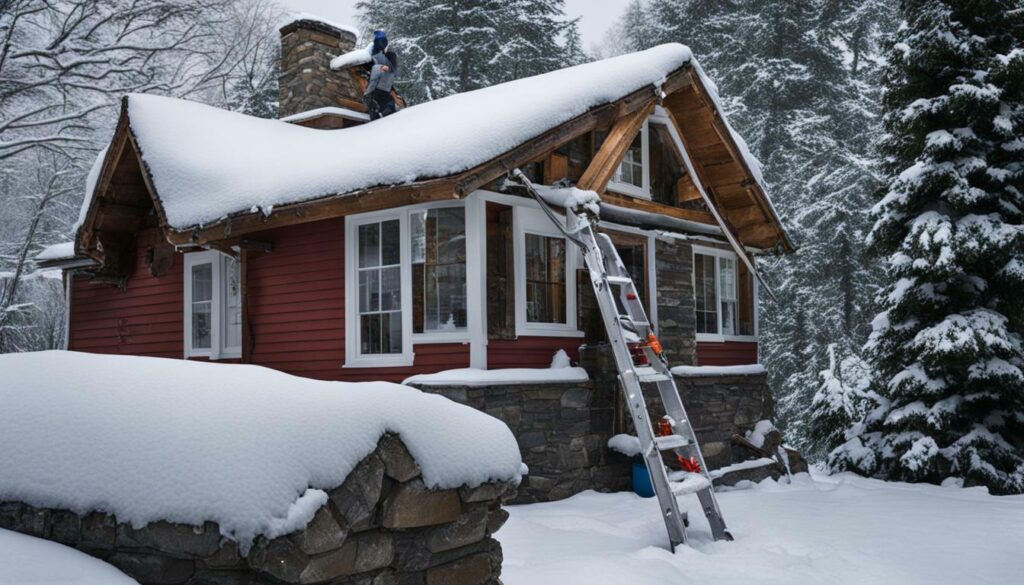
| Benefits of Repairing or Replacing Damaged Shingles: |
|---|
| 1. Prevents leaks and water damage. |
| 2. Preserves the integrity of your roof. |
| 3. Avoids costly repairs in the future. |
| 4. Enhances the overall appearance of your home. |
Trimming Tree Limbs near Your Roof
Overhanging tree limbs pose a significant risk to your roof during winter storms, with the potential to cause severe damage if not properly addressed. As winter weather approaches, it is crucial to take proactive measures to protect your roof from falling branches and potential roof collapses. Trimming tree limbs near your roof should be a top priority in your winter roof preparation checklist.
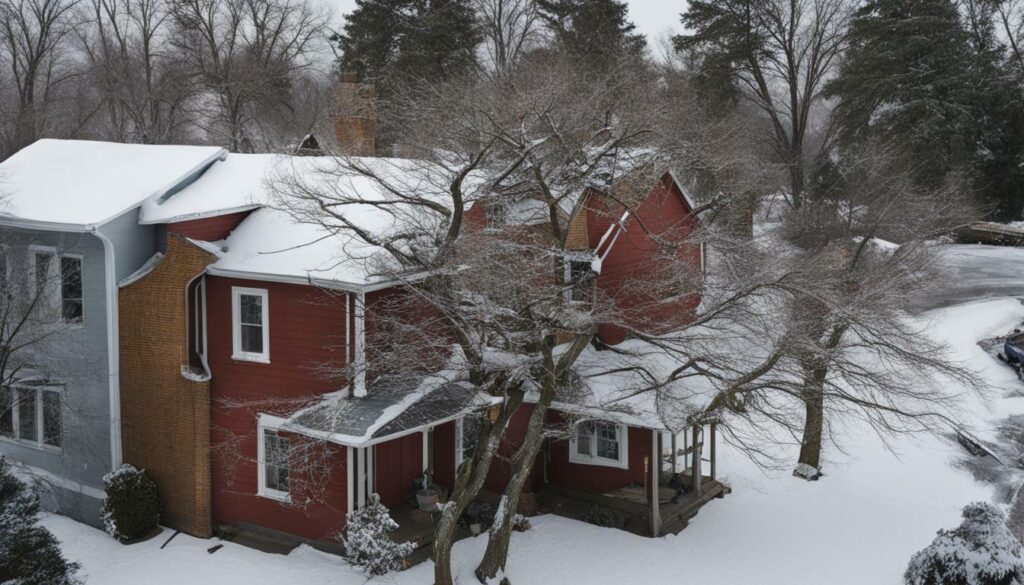
When strong winds and heavy snowfall occur, weak or overhanging tree limbs can break under the pressure, leading to structural damage and costly repairs. By trimming these branches, you are minimizing the risk of them falling onto your roof and causing leaks, punctures, or other forms of roof damage. It is recommended to hire a professional tree trimmer who has the knowledge and experience to safely remove these limbs without causing further harm to your home or surrounding property.
Benefits of Trimming Tree Limbs near Your Roof:
- Prevents roof damage: By removing overhanging branches, you reduce the risk of falling debris that could damage your roof during winter storms.
- Reduces the risk of ice dams: Overhanging branches can obstruct the flow of melting snow and ice, leading to the formation of ice dams. Trimming these branches helps prevent ice dams and the subsequent water damage they can cause.
- Improves roof ventilation: Trimming tree limbs near your roof allows for better airflow and ventilation, which helps to regulate temperature and prevent moisture buildup in your attic.
- Enhances roof lifespan: By proactively trimming tree limbs, you are safeguarding the structural integrity of your roof and increasing its overall lifespan.
Remember, safety is paramount when it comes to tree limb trimming. Avoid attempting to trim branches that are too high or require specialized equipment. Hiring a professional arborist or tree service will ensure the job is done safely and effectively, protecting both your roof and your personal well-being.
| Important Tips for Trimming Tree Limbs near Your Roof: |
|---|
| 1. Do not attempt to trim branches that are too high or inaccessible without proper equipment and training. |
| 2. Hire a professional arborist or tree service with experience in trimming branches near roofs. |
| 3. Regularly inspect your roof and surrounding trees for any signs of overhanging limbs or branches in need of trimming. |
| 4. Consider removing trees that pose a significant risk to your roof if trimming is not enough to mitigate the danger. |
Cleaning Gutters and Drain Pipes
Ensuring that your gutters and drain pipes are clean and free from debris is essential in maintaining a healthy and winter-ready roof. During winter, leaves, twigs, and other debris can accumulate in your gutters, clogging them and preventing proper water drainage. If left unchecked, this can lead to water overflow, ice dams, and potential roof damage.
To clean your gutters and drain pipes, start by using a ladder and gloves to safely remove any visible debris. You can also use a gutter cleaning tool or a garden trowel to scoop out the accumulated leaves and dirt. Once the gutters are clear, rinse them with a garden hose to flush out any remaining debris.
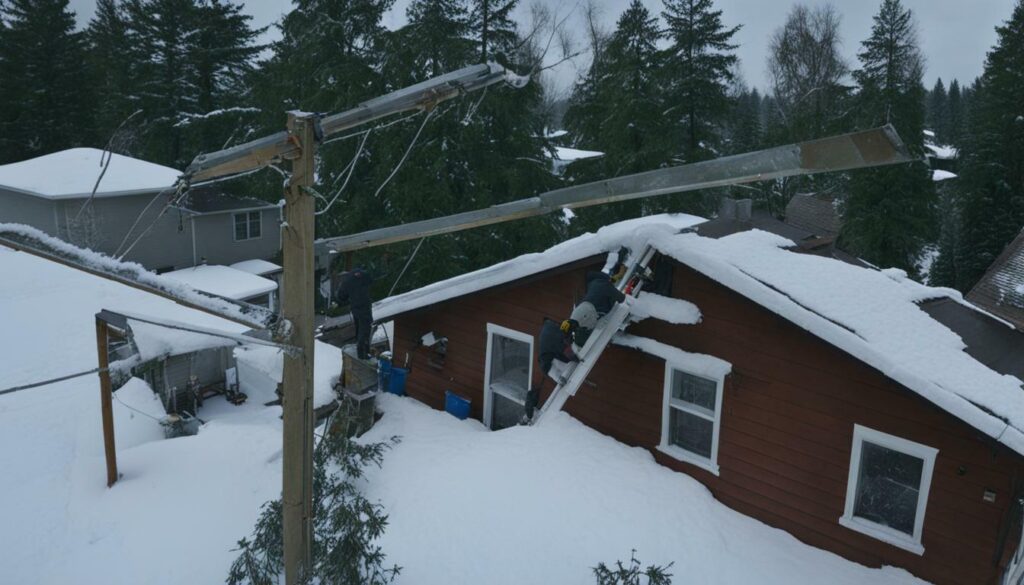
In addition to cleaning the gutters, inspect the drain pipes for any blockages. Use a plumber’s snake or a pressure washer to remove any obstructions and ensure proper water flow. It is recommended to perform regular gutter and drain pipe cleaning in the fall and throughout winter to prevent any potential issues.
| Benefits of Cleaning Gutters and Drain Pipes: |
|---|
| 1. Prevents water overflow and ice dams. |
| 2. Reduces the risk of roof leakage and damage. |
| 3. Maintains proper water drainage and prevents stagnant water buildup. |
| 4. Helps protect your home’s foundation from water damage. |
By keeping your gutters and drain pipes clean, you can ensure that water is properly directed away from your roof, preventing potential water damage and prolonging the lifespan of your roof. It is an essential part of your winter roof checklist and should be done before winter arrives.
Insulating and Ventilating Your Attic
A well-insulated and ventilated attic is crucial in preventing the formation of ice dams and the associated water damage to your roof during winter. Proper insulation helps to maintain a consistent temperature in your home, preventing warm air from escaping through the attic and melting snow on the roof. This prevents the water from refreezing at the roof’s edge, which can lead to ice dam formation.
Ice dams can cause significant damage to your roof, leading to leaks and water infiltration. To mitigate this risk, consider adding insulation to your attic. Insulating your attic floor helps to keep the warm air inside your home, reducing the chances of snow melting on the roof. This can be done using insulation materials such as fiberglass or cellulose insulation.
In addition to insulation, proper ventilation in your attic is equally important. Ventilation allows for airflow, preventing moisture buildup and reducing the likelihood of ice dams. Ridge vents, soffit vents, and gable vents are common types of attic ventilation systems. These vents help to expel moisture and regulate the temperature in the attic, preventing the formation of ice dams.
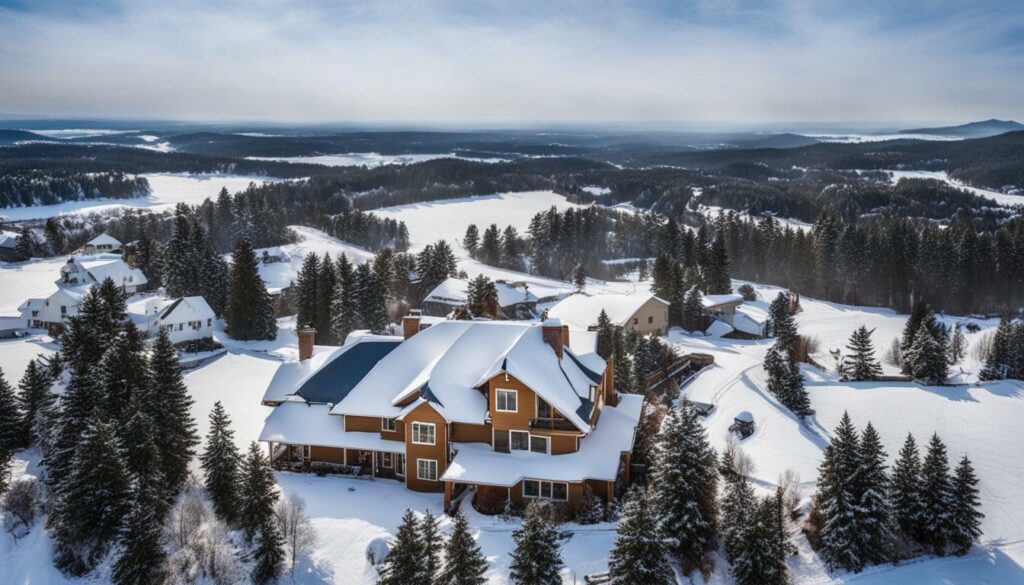
Table: Importance of Attic Insulation and Ventilation for Winter Roof Protection
| Benefits | Description |
|---|---|
| Prevents ice dam formation | Proper insulation keeps the warm air inside your home, reducing snow melting on the roof and preventing ice dams. |
| Reduces energy loss | Insulated attics help maintain a consistent temperature, reducing the need for excessive heating and lowering energy costs. |
| Prevents water damage | Effective ventilation expels moisture and prevents water buildup, reducing the risk of leaks and water damage to your roof. |
| Improves indoor comfort | Proper insulation and ventilation create a more comfortable living environment by reducing temperature variations and preventing drafts. |
- Inspect your attic for any signs of insulation gaps or damage.
- If necessary, add insulation to the attic floor to achieve the recommended R-value for your region.
- Ensure that your attic is properly ventilated with the appropriate vents and airflow system.
- Consider installing a thermal barrier, such as a radiant foil, to further enhance insulation and reflect heat.
- Regularly check the condition of your attic insulation and ventilation system to ensure proper functionality.
“A well-insulated and ventilated attic is essential in protecting your roof from winter damage. It minimizes the risk of ice dams and water infiltration, ensuring your home stays safe and dry during the cold weather.” – Roofing Expert
By insulating and ventilating your attic, you create a barrier that helps protect your roof from the harsh winter elements. This not only prevents ice dams and potential water damage but also improves energy efficiency and indoor comfort. Don’t overlook the importance of properly winterizing your roof by ensuring a well-insulated and ventilated attic, as it safeguards your home and helps you avoid costly repairs in the long run.
Remember, a comprehensive winter roof care plan includes not only insulating and ventilating your attic but also conducting regular roof inspections, repairing damaged shingles, trimming tree limbs, and cleaning gutters and drain pipes. By following these essential steps to prepare your roof for winter, you can enjoy a cozy and protected home throughout the colder months.
Professional Roof Inspection
Hiring a professional roof inspector can provide valuable insights into the condition of your roof and help identify any areas that require attention before the winter sets in. With their expertise, they can assess the overall integrity of your roof, checking for leaks, cracks, damaged shingles, or any other signs of wear and tear that may compromise its performance during the winter months.
During the inspection, the roof inspector will carefully examine the entire roof, paying close attention to areas that are prone to damage, such as flashing around chimneys or vents. They will also inspect the attic for proper insulation and ventilation, as these factors play a crucial role in preventing ice dams and water damage.
Once the inspection is complete, the roof inspector will provide you with a detailed report of their findings and recommendations. They may suggest repairs, if necessary, and advise on any preventive measures that can be taken to ensure your roof is ready to withstand the winter weather. Following their expert advice can save you from costly repairs and inconvenience caused by unexpected roof issues during the cold season.
| Benefits of Professional Roof Inspection: |
|---|
|
With a professional roof inspection, you can confidently face the winter season, knowing that your roof is well-maintained and prepared to withstand harsh weather conditions. Schedule an inspection today to safeguard your home and enjoy a worry-free winter.
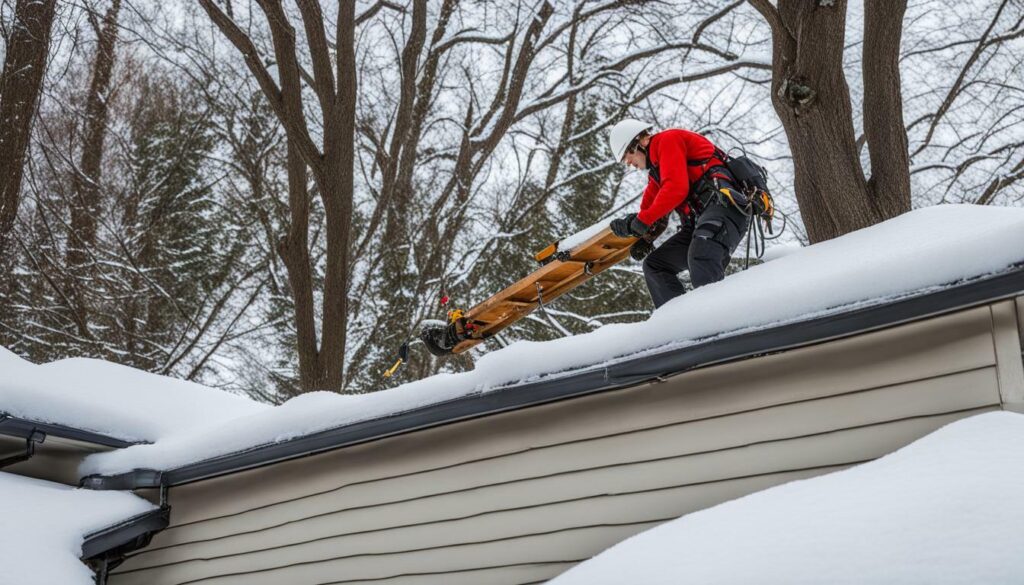
Having a well-thought-out snow removal plan is crucial in preventing snow accumulation on your roof, which can lead to structural damage and leaks. Heavy snowfall can put a significant amount of weight on your roof, causing it to sag or even collapse in extreme cases. Additionally, as the snow melts and refreezes, it can create ice dams, which can lead to water seeping into your home and causing water damage.
Here are some key steps to include in your snow removal plan:
- Invest in a roof rake: A roof rake is a handy tool that allows you to remove snow from your roof while standing safely on the ground. Use the rake to gently pull the snow off the roof, starting from the edge and working your way up. Be careful not to damage the shingles or gutters.
- Clear pathways and vents: Make sure to clear any pathways or walkways around your home to prevent accidents. It’s also important to clear any vents or exhaust pipes from snow accumulation to ensure proper ventilation.
- Monitor weather conditions: Stay informed about upcoming weather conditions and potential snowstorms. By keeping an eye on the forecast, you can plan ahead and take necessary precautions to prevent snow buildup on your roof.
Tip: Always prioritize your safety when removing snow from your roof. If you’re not comfortable or confident in doing it yourself, consider hiring a professional snow removal service.
By having a snow removal plan in place, you can minimize the risk of roof damage and protect your home during the winter months. Remember, prevention is key when it comes to maintaining the integrity of your roof.
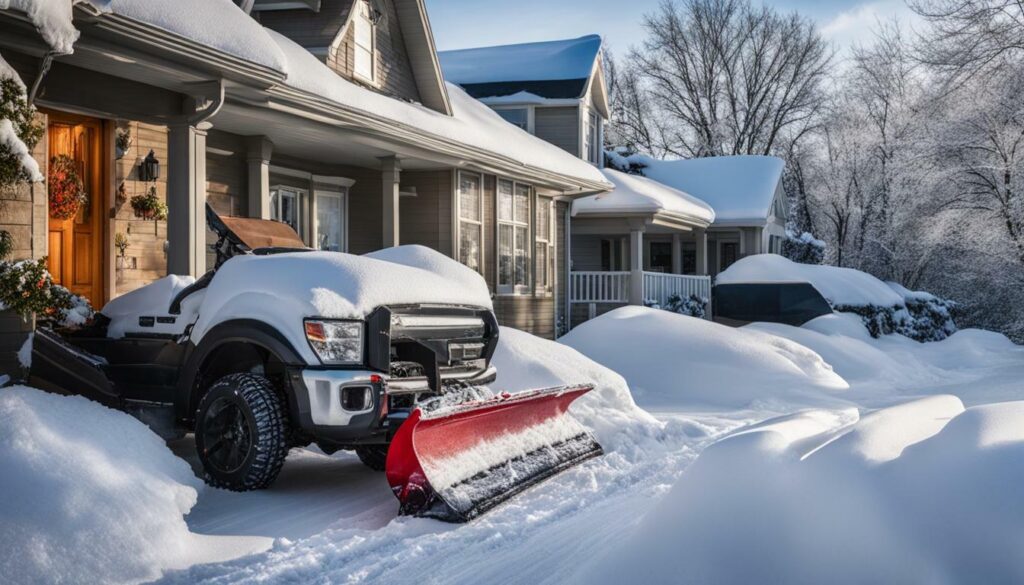
| Tips | Description |
|---|---|
| Use a roof rake | Gently remove snow from your roof using a roof rake, starting from the edge and working your way up. |
| Clear pathways and vents | Ensure pathways and walkways are clear to prevent accidents, and clear any vents or exhaust pipes from snow accumulation. |
| Monitor weather conditions | Stay informed about upcoming weather conditions and potential snowstorms to plan ahead for snow removal. |
Benefits of Winterizing Your Roof
Winterizing your roof offers numerous benefits, from saving on heating costs to protecting your home from potential water damage and improving overall insulation. By taking the necessary steps to prepare your roof for the cold weather ahead, you can ensure the safety and longevity of your home.
One of the main advantages of winterizing your roof is the potential cost savings on heating. A properly insulated and sealed roof helps to retain heat within your home, reducing the need for excessive heating and lowering your energy bills. Additionally, by preventing cold air from seeping into your home through gaps or cracks in the roof, you can maintain a comfortable indoor temperature throughout the winter months.
Another significant benefit of winterizing your roof is the protection it provides against potential water damage. By inspecting your roof for any damages and ensuring that all shingles are in good condition, you can prevent leaks and water infiltration. This is particularly important during winter, when freezing temperatures can cause water to expand and lead to structural damage. Additionally, cleaning your gutters and drain pipes helps to prevent water from backing up and causing issues, such as ice dams.
Lastly, winterizing your roof improves overall insulation, which has a positive impact on your home’s energy efficiency. Proper attic insulation and ventilation prevent heat loss and maintain a consistent temperature throughout your home. This not only reduces heating costs but also contributes to a more comfortable living environment for you and your family.
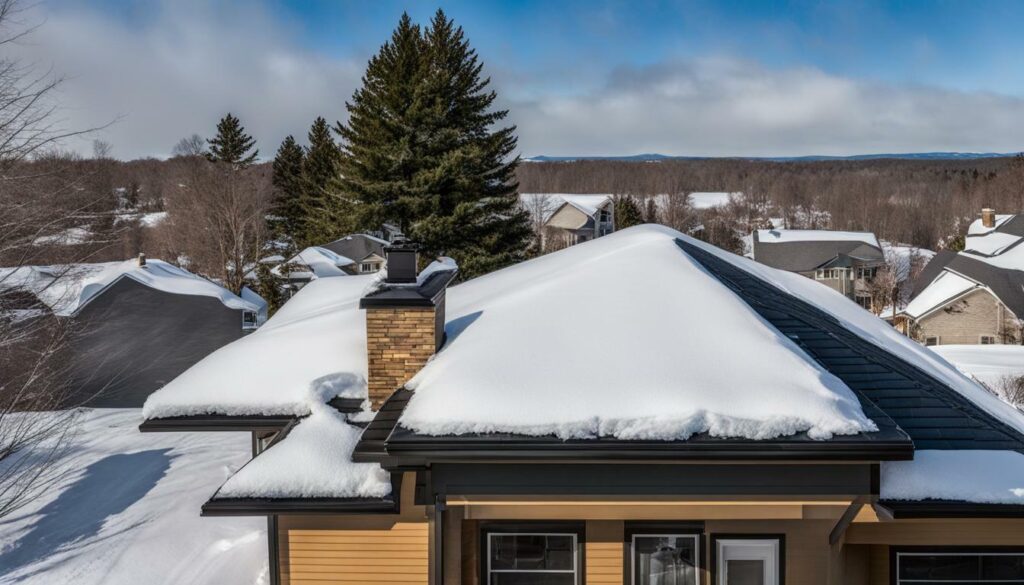
Winterizing your roof is a crucial step in preparing your home for the winter season. By investing time and effort into inspecting, repairing, and maintaining your roof, you can avoid potential damage, reduce energy costs, and ensure a safe and comfortable living space for your family.
Conclusion
Taking the necessary steps to winterize your roof can make a significant difference in protecting your home during the cold winter months. Act now to secure your home and prevent costly repairs in the future.
Before winter arrives, it’s crucial to inspect your roof for any damages. Replace missing or cracked shingles to ensure the durability and integrity of your roof. By doing so, you can prevent water leaks and potential structural issues that can arise from winter weather conditions.
Additionally, trim back any tree limbs that are close to your house. During winter storms, these limbs can break and fall onto your roof, causing severe damage. By proactively trimming them, you can avoid these risks and keep your roof protected.
Don’t forget to clean your gutters and drain pipes. Clearing out debris will prevent water from backing up and causing potential water damage. This step is essential in maintaining your roof’s functionality and preventing the formation of ice dams.
Ensure your attic is properly insulated and ventilated. Adequate insulation helps prevent heat loss, which can lead to ice dams and water damage. Proper ventilation allows excess moisture to escape, decreasing the risk of condensation and mold growth. Together, insulation and ventilation are vital in safeguarding your roof during winter.
Consider getting a professional roof inspection. Experts can identify weak points and potential problems that may not be visible to the untrained eye. This thorough inspection can help you address any issues before they worsen, protecting your home and saving you money in the long run.
Lastly, have a plan for snow removal. Excessive snow buildup on your roof can lead to structural damage and leaks. Clearing snow regularly and safely can prevent these issues and avoid costly repairs.
Winterizing your roof offers numerous benefits beyond protecting your home. It can help save on heating costs by maintaining a well-insulated and sealed environment. It also shields your home from water damage, making sure you stay dry even during harsh winter weather.
In summary, winterizing your roof is a crucial step in preparing your home for the winter months. Taking these proactive measures will ensure the longevity and durability of your roof and provide peace of mind throughout the season. Act now and make winterizing your roof a priority before the cold weather arrives.
FAQ
Q: Why is winterizing your roof important?
A: Winterizing your roof is essential to protect your home during the cold weather. It helps secure your home, prevent water damage, save on heating costs, and improve insulation.
Q: How do I inspect my roof for damages?
A: Before winter arrives, visually inspect your roof for any damages such as missing or cracked shingles. Look for signs of wear and tear, leaks, or loose roofing material.
Q: What should I do if I find damaged shingles?
A: If you find damaged shingles, it is important to repair or replace them to ensure the durability and protection of your roof. Consult a professional if you are unsure how to do this.
Q: Why is trimming tree limbs near my roof important?
A: Trimming tree limbs close to your house helps prevent them from falling on your roof during storms, reducing the risk of damage to your roof and home.
Q: How often should I clean my gutters and drain pipes?
A: It is recommended to clean your gutters and drain pipes at least twice a year, before winter and after fall, to prevent water damage and ice dams.
Q: Why is proper attic insulation and ventilation important?
A: Proper attic insulation and ventilation prevent water from freezing and expanding beneath the shingles, which can cause damage. It also helps regulate temperature and prevent ice dams.
Q: Why should I get a professional roof inspection?
A: A professional roof inspection can identify weak points, potential problems, and recommend necessary repairs or maintenance before winter. It ensures your roof is in optimal condition.
Q: Why do I need a snow removal plan?
A: Having a snow removal plan helps prevent heavy snow buildup on your roof, which can lead to structural damage. It ensures the safety and integrity of your roof during winter.
Q: What are the benefits of winterizing your roof?
A: Winterizing your roof helps save on heating costs, protect your home from water damage, improve insulation, and ensure the durability of your roof during the harsh winter months.
